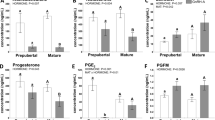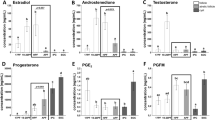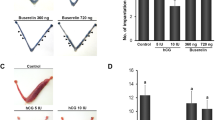Abstract
IN the primate, the corpus luteum formed after ovulation has a relatively short life span. If the ovum becomes fertilised, however, the presence of the embryo in the uterus leads to ‘rescue’ of the corpus luteum and a prolongation of its functional life1. Circumstantial evidence suggests that this is achieved through the elaboration of a luteotrophic substance (chorionic gonadotrophin) by the trophoblastic cells of the implanting embryo1,2. Based on differences in the plasma progesterone levels of pregnant and pseudopregnant animals, a similar situation has been proposed for the rabbit3. In support of this, the blastocyst fluid from 6-d pregnant rabbits has been reported to contain a substance similar to human chorionic gonadotrophin (HCG), by a radioreceptor assay4, and a substance similar to luteinising hormone (LH), by a heterologous radioimmunoassay5. Our study was initiated to identify definitively the source of the HCG-like substance in the rabbit blastocyst. Using a highly sensitive in vitro bioassay method we have examined the concentration of HCG-like material in the serum throughout pregnancy and in the blastocyst from days 4 to 7 of pregnancy. We report here that the rabbit blastocyst does not contain or secrete any gonadotrophin which has significant HCG-like activity.
This is a preview of subscription content, access via your institution
Access options
Subscribe to this journal
Receive 51 print issues and online access
$199.00 per year
only $3.90 per issue
Buy this article
- Purchase on Springer Link
- Instant access to full article PDF
Prices may be subject to local taxes which are calculated during checkout
Similar content being viewed by others
References
Knobil, E., Biol Reprod., 8, 246–258 (1973).
Tullner, W. W., Acta Endocr. (Kbh) suppl., 166, 200–213 (1971).
Fuchs, A. R., and Beling, C. C., Endocrinology, 94, 1054–1058 (1974).
Haour, F., and Saxena, B. B., Science, 185, 444–445 (1974).
Fujimoto, S., Euker, J. S., Riegel, G. D., and Dukelow, W. R., Proc. Japan Acad., 51, 123–125 (1975).
Dufau, M. L., Catt, K. J., and Tsuruhara, T., Endocrinology, 90, 1032–1040 (1972).
VanDamme, M. P., Robertson, D. M., and Diczfalusy, E., Acta Endocr. (Kbh), 77, 655–671 (1974).
Scaramuzzi, R. J., Blake, C. A., Papkoff, H., Hilliard, J., and Sawyer, C. H., Endocrinology, 90, 1285–1291 (1972).
Catt, K. J., Dufau, M. L., and Vaitukaitis, J. L., J. clin. Endocr. Metab., 40, 537–540 (1975).
Hilliard, J., Biol. Reprod., 8, 203–221 (1973).
Holt, J. A., Wilson, S. M., and Keyes, P. L., Fedn Proc., 34, 592 (1975).
Wiley, L. D., Nature, 252, 715–716 (1974).
Martin, B. J., Spicer, S. S., and Smythe, N. M., Anat. Rec., 178, 769–786 (1974).
Author information
Authors and Affiliations
Rights and permissions
About this article
Cite this article
SUNDARAM, K., CONNELL, K. & PASSANTINO, T. Implication of absence of HCG-like gonadotrophin in the blastocyst for control of corpus luteum function in pregnant rabbit. Nature 256, 739–741 (1975). https://doi.org/10.1038/256739a0
Received:
Accepted:
Issue Date:
DOI: https://doi.org/10.1038/256739a0
Comments
By submitting a comment you agree to abide by our Terms and Community Guidelines. If you find something abusive or that does not comply with our terms or guidelines please flag it as inappropriate.



